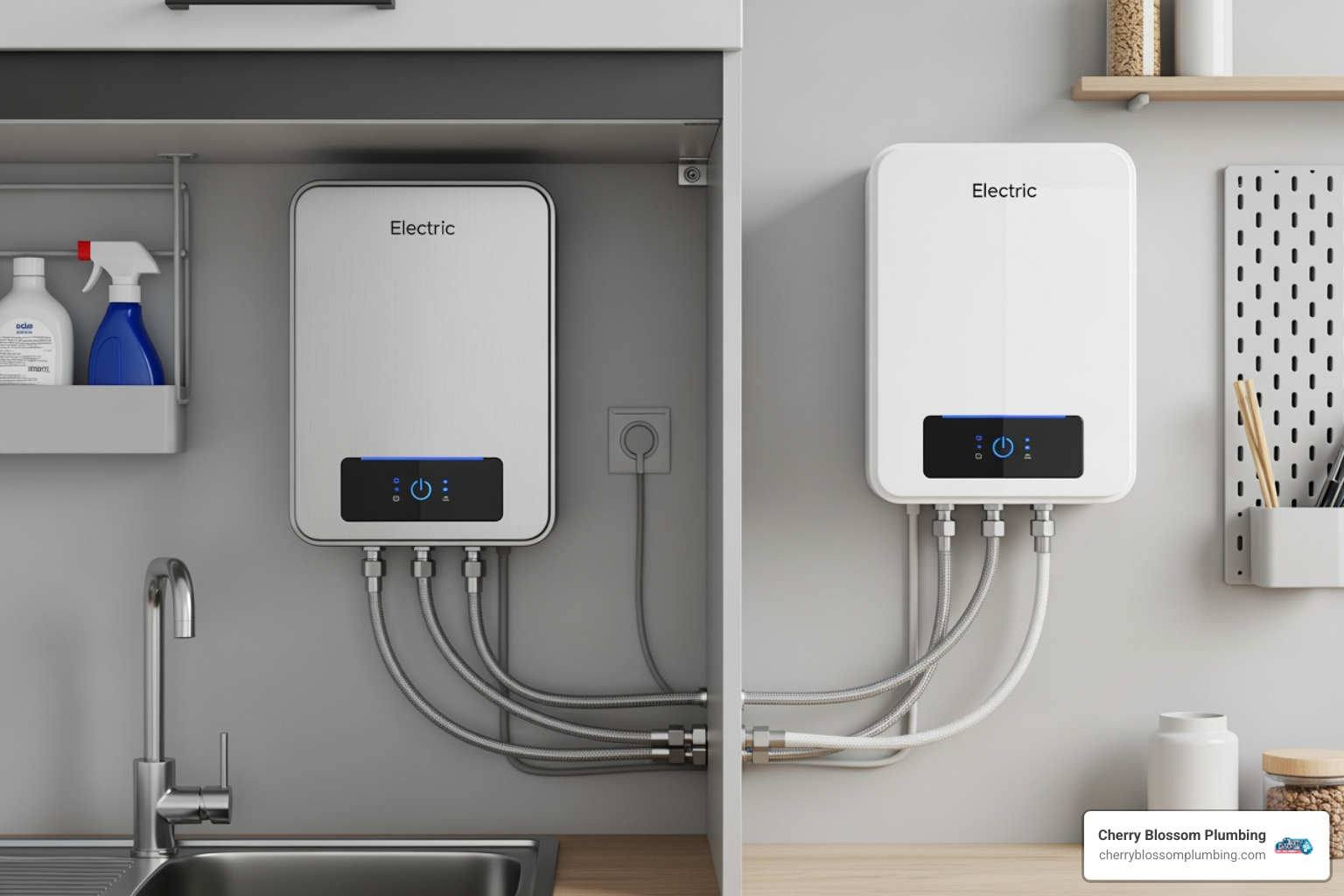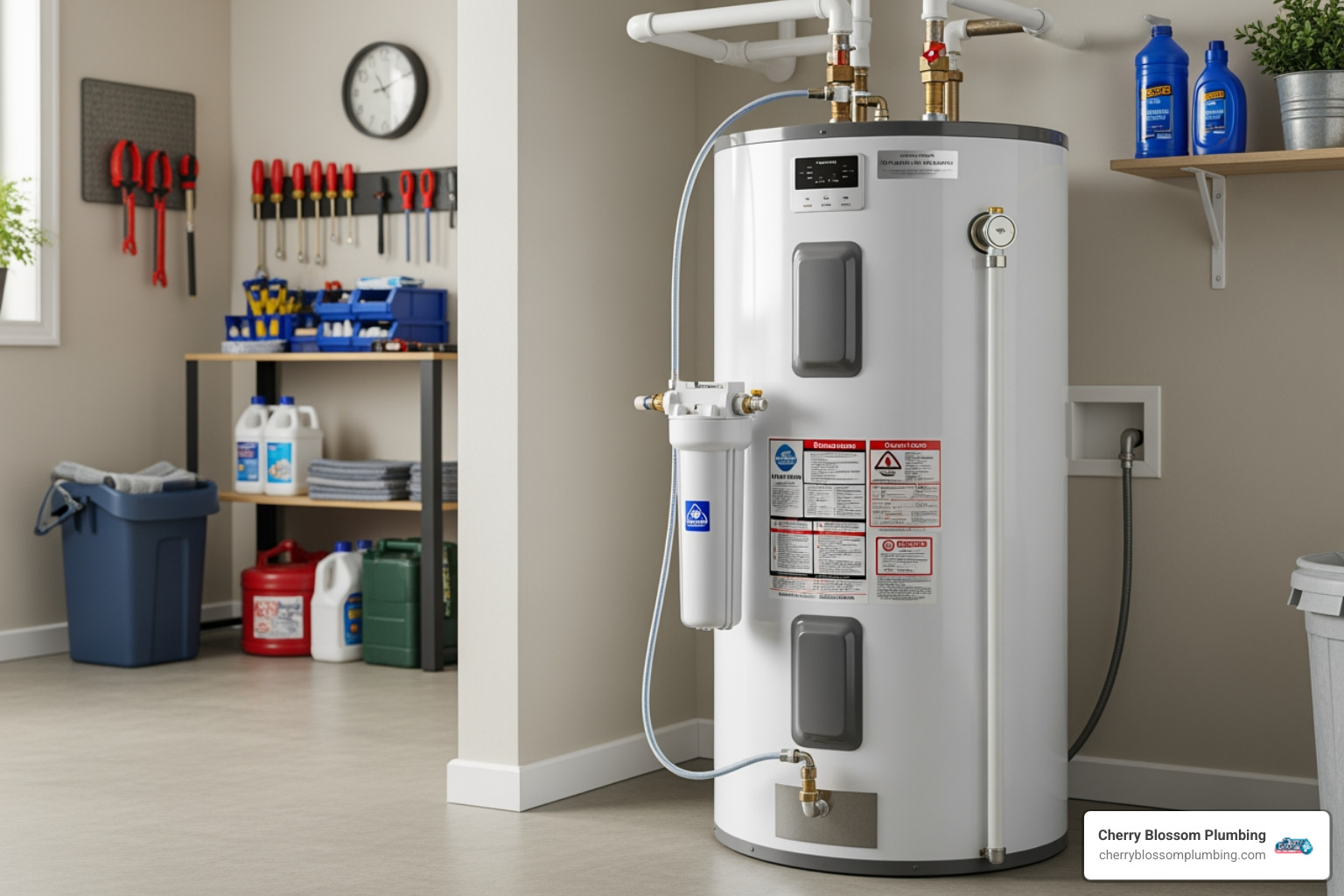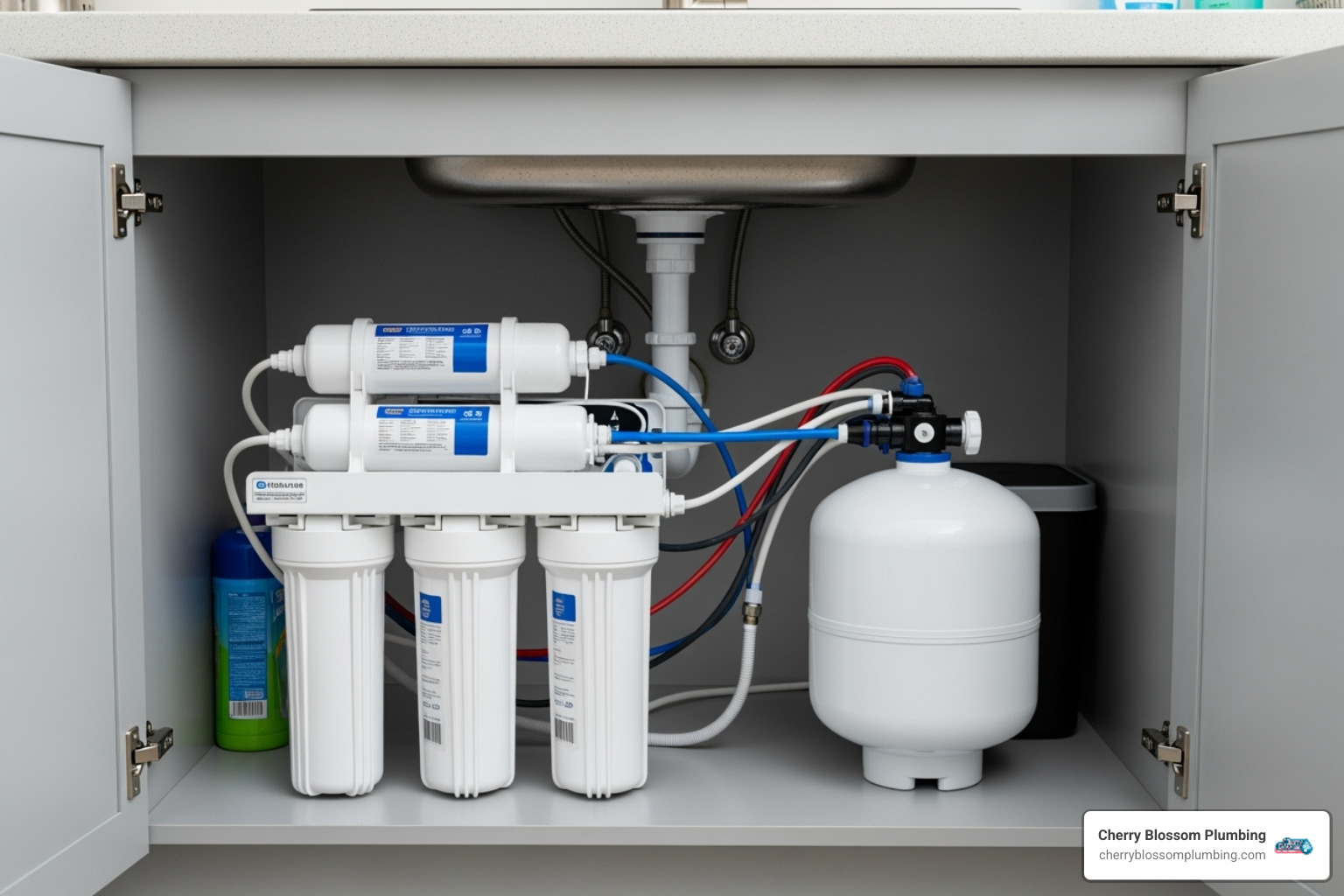
What Are 'Forever Chemicals' and Why Are They in Your Water?
A pfas removal system is essential for protecting your family from harmful "forever chemicals" that contaminate tap water across America. PFAS (per- and polyfluoroalkyl substances) are synthetic chemicals that don't break down naturally and accumulate in our bodies over time.
Top PFAS Removal Technologies:
- Granular Activated Carbon (GAC) - Most studied, effective for long-chain PFAS
- Ion Exchange (IX) - High capacity, removes negatively charged PFAS
- Reverse Osmosis (RO) - Most effective overall, removes 90%+ of all PFAS types
- Nanofiltration (NF) - Good for larger PFAS molecules, less effective on short-chain
These chemicals are everywhere in modern life. They make cookware non-stick, keep food packaging grease-proof, and help firefighting foam work effectively. But their usefulness comes with a serious downside - they persist in the environment and human body for decades.
PFAS contamination is widespread. A 2023 U.S. Geological Survey study found that at least 45 percent of the nation's tap water contains some type of PFAS. These "forever chemicals" have been linked to cancer, liver damage, fertility problems, and immune system disorders.
The problem hits close to home here in Northern Virginia. Arlington County's water contains more chlorine than a swimming pool, but standard municipal treatment doesn't remove PFAS. If you don't have a proper filter system, you become the filter.
I'm Amanda Casteel, and through my work with Cherry Blossom Plumbing, I've seen how choosing the right pfas removal system can transform a family's peace of mind about their water quality. My background in systems management and water treatment has taught me that effective PFAS removal requires understanding both the technology and your specific water conditions.

Comparing the Top PFAS Removal System Technologies
When you're shopping for a pfas removal system, you're essentially choosing between three main approaches: trapping the chemicals, swapping them out, or physically blocking them from your water. Think of it like choosing between different types of nets to catch fish - each one works differently and catches different sizes.
Most home systems work through sequestration rather than destruction. In simple terms, they grab the PFAS and hold onto them, but the chemicals still exist somewhere - they're just not in your drinking water anymore. It's like moving the problem rather than solving it completely, but that's exactly what we want for protecting your family.
You'll also need to decide between point-of-entry (POE) systems that treat all the water coming into your home, or point-of-use (POU) systems that clean water at just one location, like your kitchen sink. POE gives you whole-house protection, while POU focuses on your drinking and cooking water.
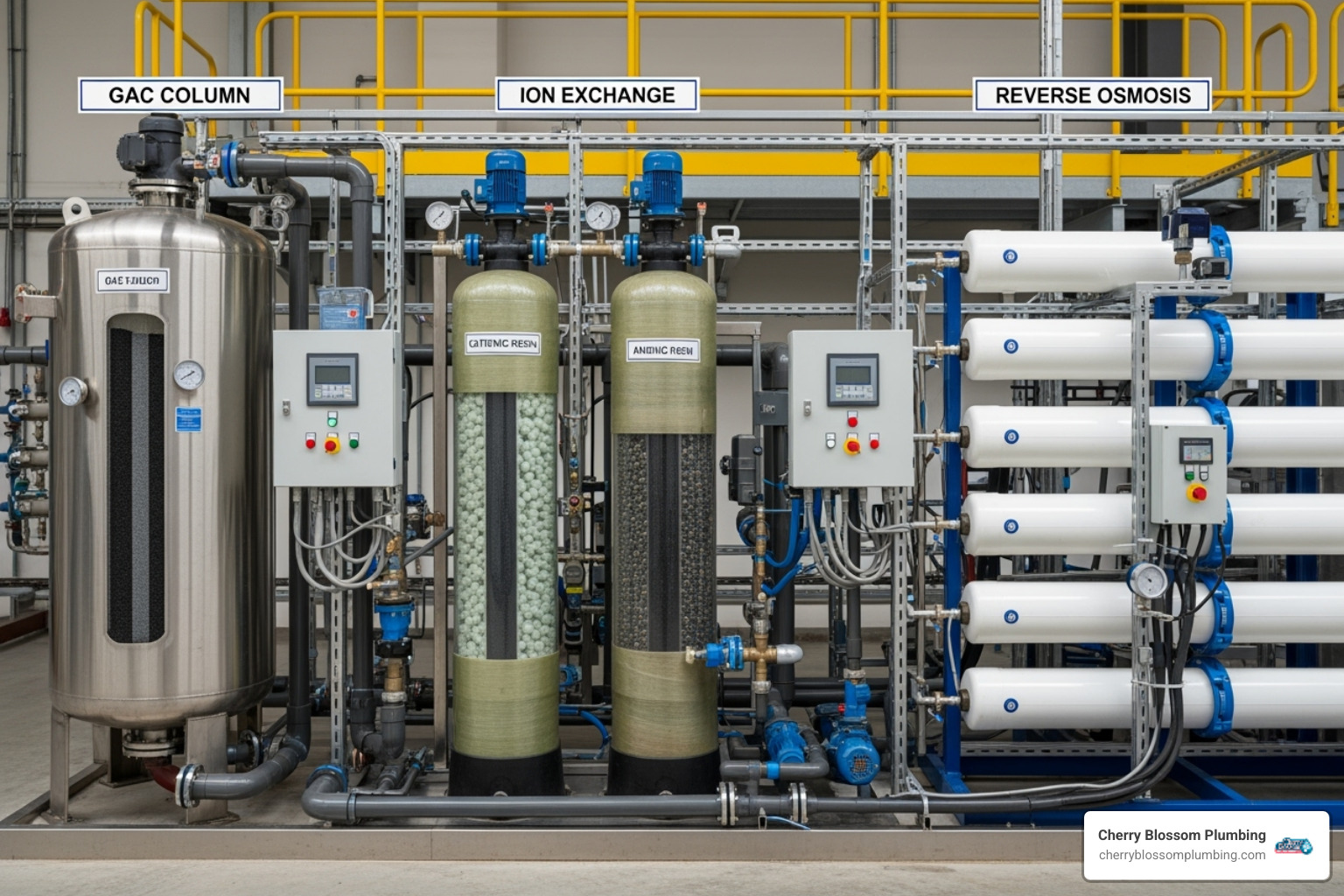
Granular Activated Carbon (GAC) and Ion Exchange (IX)
Let's start with the two workhorses of PFAS removal: Granular Activated Carbon (GAC) and Ion Exchange (IX) systems. These technologies have been around the block and have proven track records.
GAC works like nature's ultimate sponge. Made from materials like wood or coal that are heated and processed to create millions of tiny pores, GAC has an enormous surface area packed into a relatively small space. When water flows through, PFAS molecules get stuck in these microscopic pockets through a process called adsorption.
Here's what makes GAC special: it's the most studied technology for PFAS removal, which means we have lots of real-world data on how well it works. For longer-chain PFAS like PFOA and PFOS (the ones that get the most attention in the news), GAC can be incredibly effective - sometimes achieving 100 percent removal when the system is fresh and properly sized.
But GAC has its limitations. Shorter-chain PFAS are trickier customers - they don't stick as well and can slip through faster. Plus, other organic matter in your water competes with PFAS for those precious adsorption spots, which can reduce both effectiveness and how long the carbon lasts.
Ion Exchange (IX) resins work more like tiny magnets. These specialized plastic beads are designed with charged sites that attract oppositely charged particles. Since many PFAS become negatively charged in water, positively charged IX resins can grab them and swap them out for harmless ions.
IX systems often outperform GAC in certain situations, especially when dealing with a wider variety of PFAS types or very low concentrations. They're particularly effective at removing negatively charged PFAS ions. However, other negatively charged particles in your water - like sulfates and nitrates - can compete with PFAS for those binding sites.
Both GAC and IX face the same challenge: what to do with the spent media once it's full of PFAS. The contaminated carbon or resin needs to be disposed of properly, and that concentrated PFAS doesn't just disappear. It's an ongoing consideration that affects both cost and environmental impact.
If you're interested in learning more about how these technologies fit into broader water treatment approaches, check out our guide on Water Filtration Systems.
High-Pressure Membranes: Reverse Osmosis (RO) & Nanofiltration (NF)
Now we're getting to the heavy-duty champions of water purification: Reverse Osmosis (RO) and Nanofiltration (NF) systems. If GAC and IX are like nets that catch contaminants, these membrane systems are like ultra-fine sieves that physically block almost everything except pure water molecules.
The concept is beautifully simple: use pressure to force water through a membrane with incredibly tiny pores. Water molecules are small enough to pass through, but PFAS, bacteria, viruses, salts, and other dissolved solids are too big and get left behind.
The performance numbers are impressive. RO and NF systems typically achieve more than 90 percent removal of PFAS across the board. RO membranes, being even tighter than NF, often hit greater than 99 percent removal rates. This works for both the stubborn short-chain PFAS that give other systems trouble and the easier-to-remove long-chain varieties.
But there's a trade-off that's important to understand. These systems create a concentrated waste stream that gets flushed down the drain. About 20 percent of your incoming water becomes this concentrated "reject" water containing all the contaminants that were filtered out. It's like the system sacrifices some water to make the rest perfectly clean.
This waste stream consideration affects both water efficiency and environmental impact. You're using more water overall, and that concentrated PFAS is going somewhere - typically into the municipal wastewater system. For point-of-use applications like under-sink systems, this is usually manageable. For whole-house systems, it becomes a bigger factor.
RO and NF systems also typically require pre-treatment to protect those delicate membranes from damage. Sediment, chlorine, and hard water minerals can foul or damage the membranes, so most systems include pre-filters that need regular replacement.
Despite these considerations, the broad-spectrum effectiveness of membrane systems makes them excellent choices when you want the highest level of protection. They're particularly popular for point-of-use applications where you're treating smaller volumes of water for drinking and cooking.
For more insights into how these advanced systems can fit into your home's water treatment strategy, explore our Home Water Filtration Guide.
Comparing PFAS Removal Technologies
Here's how the main pfas removal system technologies stack up against each other:
| Technology | Effectiveness (Long-chain) | Effectiveness (Short-chain) | Waste Stream | Water Efficiency | General Maintenance Considerations |
|---|---|---|---|---|---|
| Granular Activated Carbon (GAC) | High | Moderate to Low | Saturated media requires proper disposal | High | Regular media replacement (can be frequent depending on water quality) |
| Ion Exchange (IX) | High | High to Moderate | Saturated media requires proper disposal/regeneration | High | Regular media replacement or regeneration (can be frequent) |
| Reverse Osmosis (RO) | Very High (>99%) | Very High (>99%) | Concentrated wastewater flushed to drain | Low to Moderate | Pre-filter changes, membrane replacement (less frequent) |
| Nanofiltration (NF) | High (>95%) | Moderate to Low | Concentrated wastewater flushed to drain | Low to Moderate | Pre-filter changes, membrane replacement (less frequent) |
The key takeaway? Each technology has its sweet spot. Your water chemistry, PFAS levels, flow rate needs, and maintenance preferences all play a role in determining which approach works best for your family's situation.
How to Choose the Right Solution for Your Home
Selecting the perfect pfas removal system for your family is like choosing a security system for your home – it needs to match your specific situation and provide the protection you need. The truth is, water chemistry varies dramatically from house to house, even within the same neighborhood here in Northern Virginia.
Your home's unique water profile plays a huge role in system performance. High chlorine levels, sediment, or natural organic matter can compete with PFAS for treatment sites in GAC and IX systems, while these same contaminants can clog the delicate membranes in reverse osmosis units. That's why cookie-cutter solutions rarely work as well as they promise.
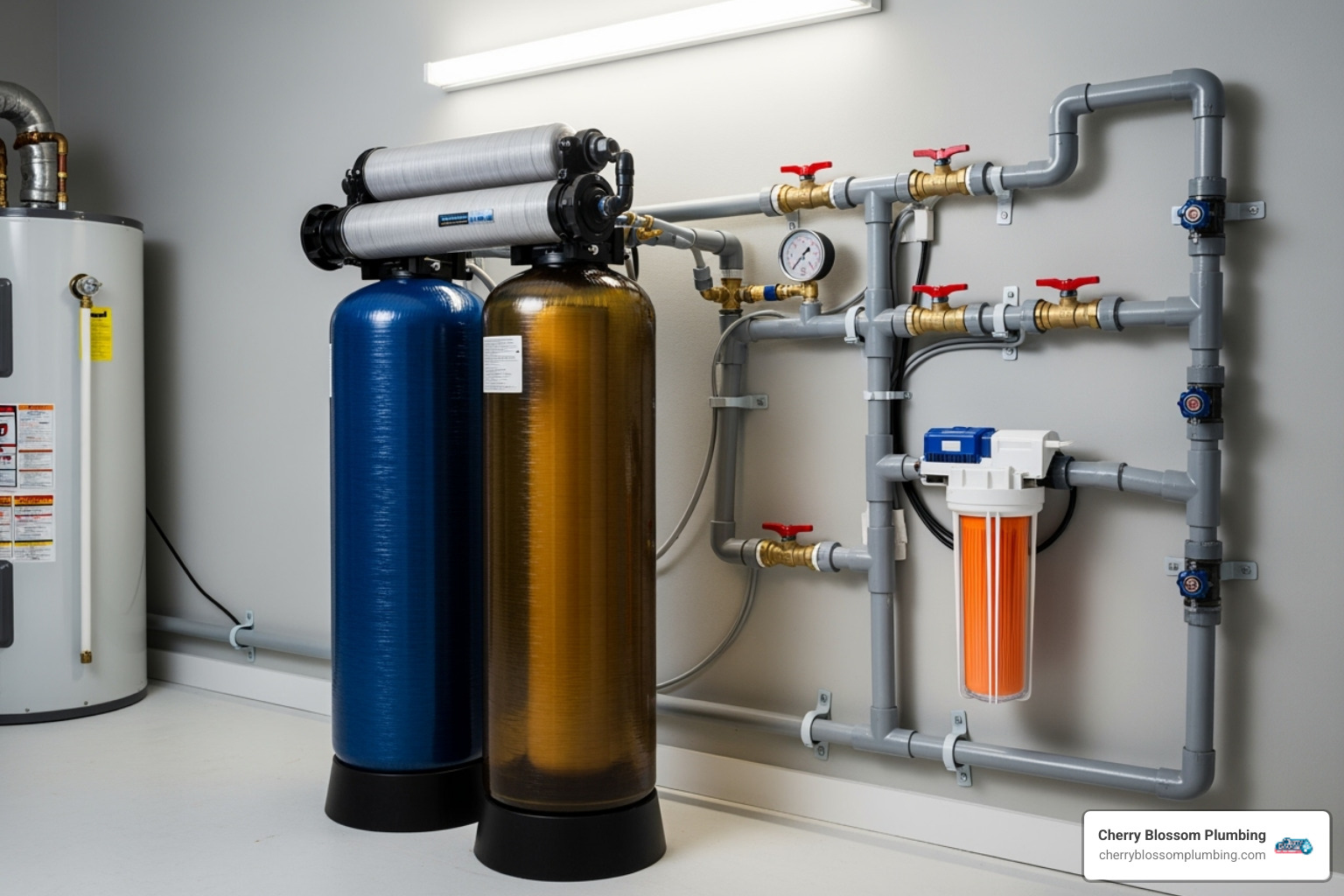
Key Factors in Choosing a Home PFAS Removal System
When families in Arlington, Fairfax, and McLean call us about installing a pfas removal system, I always tell them we're going to be detectives first. Here's what we investigate together:
Start with your water test results. You wouldn't take medicine without knowing what's wrong with you, and the same logic applies here. A comprehensive water analysis reveals not just PFAS levels, but also the supporting cast of contaminants that could affect your system's performance. Some families are shocked to find their "clean" municipal water contains chlorine levels that could damage certain filtration media.
Consider your household's water flow rate needs. Do you have teenagers who take 20-minute showers? A large family that runs multiple appliances simultaneously? Your daily water usage patterns help determine whether you need a whole-house (POE) system that treats every drop entering your home, or a point-of-use (POU) system focused on drinking and cooking water.
Whole-house systems provide comprehensive protection – PFAS-free water for everything from your morning coffee to your evening bath. We've installed these robust solutions throughout Falls Church and Alexandria, giving families complete peace of mind. Point-of-use systems, like under-sink units, offer targeted protection at a lower cost but don't address PFAS exposure from showering or other household uses.
Think honestly about your maintenance commitment. Every effective system requires some TLC. GAC and IX systems might need media changes every 6-12 months depending on your water quality, while RO membranes typically last 2-3 years but require pre-filter changes more frequently. We've learned that matching the maintenance schedule to your lifestyle prevents systems from becoming ineffective due to neglect.
For personalized guidance that considers your home's unique water chemistry and usage patterns, our team specializes in Water Filtration in Arlington, VA and can help you steer these important decisions.
The Role of Certifications in Ensuring Effectiveness
Here's where things get tricky – the water treatment industry has its share of snake oil salesmen making wild claims about PFAS removal. I've seen systems advertised as "removing 99% of all contaminants" that couldn't remove much more than bad taste.
Independent third-party certifications are your shield against marketing nonsense. These aren't just fancy logos; they represent rigorous testing by organizations like NSF International and the Water Quality Association that have no financial stake in whether a product passes or fails.

NSF/ANSI Standard 53 certification proves that adsorption systems like GAC have been tested specifically for PFOA and PFOS reduction. NSF/ANSI Standard 58 certification does the same for reverse osmosis systems. These standards require products to reduce PFAS to below EPA maximum contaminant level goals under real-world conditions.
When we recommend systems to families in Oakton, Springfield, and McLean, we always verify certifications first. A manufacturer can claim their system removes PFAS, but without proper certification, you're basically taking their word for it. The NSF website lets you search for certified products, making it easy to separate legitimate solutions from marketing hype.
The bottom line? If a pfas removal system doesn't have the right certifications for PFAS reduction, keep shopping. Your family's health deserves better than unproven promises.
Taking Action: Testing Your Water and Understanding Regulations
Feeling overwhelmed by all this talk of "forever chemicals" and complex filtration systems? You're not alone! But here's the thing – taking action is actually the most empowering step you can make for your family's health. Think of it like getting a health checkup – you can't treat what you don't know about.
The journey to cleaner, safer water starts with understanding what's coming out of your taps right now. And honestly, it's easier than you might think.
How to Determine if Your Water Contains PFAS
Before you invest in any pfas removal system, you need to know if PFAS are actually lurking in your water – and if so, how much. It's like trying to fix a car without knowing what's wrong with it first.
Start with your utility's Consumer Confidence Report (CCR). If you're on municipal water in Fairfax, Alexandria, or anywhere in Northern Virginia, your water utility has to test for regulated contaminants and share the results with you every year. It's called a Consumer Confidence Report, and you can usually find it on your water supplier's website or just call and ask for a copy. While not every utility tests for PFAS yet (regulations are still catching up), this report gives you a solid starting point.
Private well owners, this one's on you. If your water comes from a private well, you're the quality control manager. This is especially important if you live near areas where industrial activities or military bases operate – both are known sources of PFAS contamination.
When it comes to actual testing, you have a couple of solid options. Mail-in test kits offer convenience and have gotten much better in recent years. They're a great starting point, especially for well owners who want to get a quick read on their water quality.
But for the most comprehensive and accurate analysis, we always recommend going with an EPA-certified lab. These labs use rigorous methods to detect PFAS and other contaminants at very low concentrations – we're talking parts per trillion, which is incredibly precise. It's like having a microscope versus a magnifying glass.
Knowing what's in your water puts you in the driver's seat. You can make informed decisions and choose a pfas removal system that actually addresses your specific situation, rather than guessing.
Understanding Your Whole-House PFAS Removal System Options
The rules around PFAS in drinking water are changing faster than a Northern Virginia traffic pattern. The EPA established nationwide limits for PFAS in drinking water in 2024, and several states have jumped ahead with their own even stricter guidelines. This regulatory momentum means one thing: standards are getting tougher, and effective treatment is becoming more important than ever.
For homeowners in Vienna, McLean, or anywhere throughout Northern Virginia, sorting through these regulations and understanding your whole-house pfas removal system options can feel like reading a manual in another language. That's where professional expertise becomes your best friend.
Installing a whole-house system isn't like swapping out a showerhead – it's a significant investment that requires careful planning. Professional installation ensures optimal performance by sizing the system correctly for your home's specific water usage and plumbing setup. We've seen too many DIY disasters where incorrect installation led to leaks, reduced effectiveness, or even damage to existing plumbing.
A properly installed system gives you peace of mind. When you know your system is installed to the highest standards by experienced professionals, you can trust the water flowing from every single tap in your home. No more wondering, no more worrying – just clean water.
At Cherry Blossom Plumbing, we understand the unique water challenges that come with living in our area. From Arlington's aging infrastructure to Falls Church's varying water pressure, we've seen it all. Our commitment is helping you find the right solution with our signature "WOW factor" guarantee – because your family deserves nothing less than exceptional service.
Ready to explore your options and get expert advice custom specifically to your home? We invite you to Explore Water Filtration Services and take the first step toward cleaner, safer water for your family.
Frequently Asked Questions about PFAS Removal
We often hear similar questions from homeowners concerned about PFAS in their water. Let's tackle some of the most common ones to help clarify your understanding of a pfas removal system.
Do standard water pitcher filters remove PFAS?
This is a great question, and honestly, the answer might surprise you: it really depends on which pitcher you choose! Not all water pitcher filters are created equal when it comes to tackling these stubborn "forever chemicals."
Some pitcher filters are absolute champions at PFAS removal. In our research, we've found that certain models like the Travel Berkey and Zero Water have achieved 100 percent removal of tested PFAS in studies. The Epic Pure Pitcher came pretty close too, removing about 98 percent. But here's where it gets tricky – other popular brands that you might recognize from the grocery store performed much lower, with some reducing PFAS by only 22 percent or 48 percent.
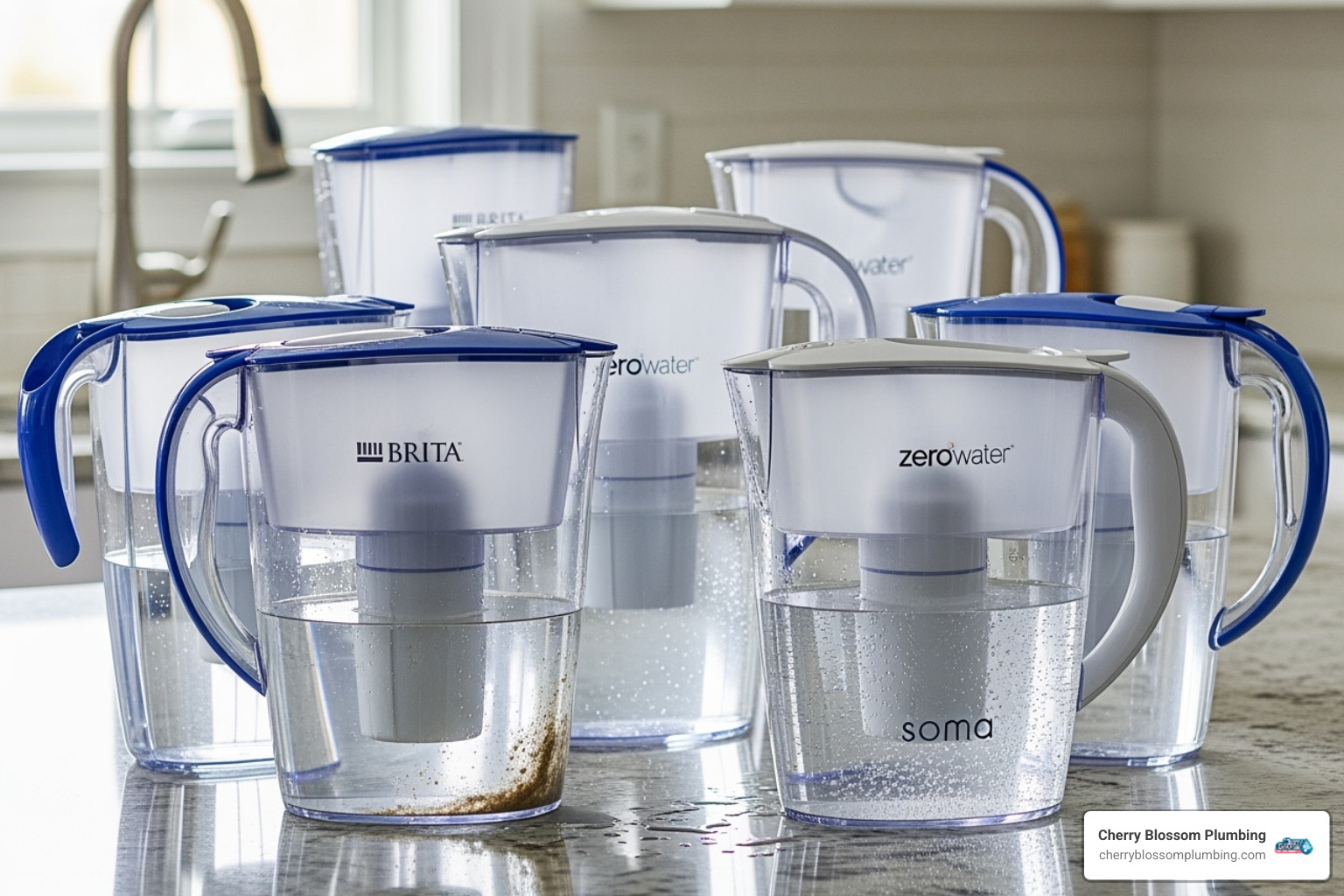
The secret is certification. Always look for pitcher filters that are independently certified by organizations like NSF, WQA, or IAPMO specifically for PFAS reduction. You want to see that NSF/ANSI 53 certification stamp that we talked about earlier. Without this certification, any claims about PFAS removal are just marketing talk.
Even with the best certified pitcher filters, remember they're only treating the water you pour from the pitcher. You're still getting PFAS exposure from showering, washing dishes, and cooking. That's why many families in Arlington and Falls Church eventually decide they need a more comprehensive pfas removal system for their whole home.
How do short-chain vs. long-chain PFAS affect treatment?
Think of PFAS like a family with different personalities – some are easy to catch, others are escape artists. The difference comes down to their "chain length," which is basically how many carbon atoms they have strung together.
Long-chain PFAS like PFOA and PFOS are the bigger, stickier cousins. They have more carbon atoms, making them larger and more hydrophobic (they don't like water as much). This makes them easier targets for GAC and IX systems to grab onto and hold. It's like trying to catch a basketball – it's big enough that your net can easily snag it.
Short-chain PFAS like PFBS and PFBA are the troublemakers. They're smaller, more hydrophilic (they love water), and much more mobile. They slip through GAC and IX filters like a tennis ball through a basketball net. These little guys can "break through" filters much faster, meaning your filter becomes saturated and stops working sooner than you'd expect.
This is exactly why Reverse Osmosis (RO) systems are so effective – they don't rely on chemical attraction like GAC and IX do. Instead, they physically block molecules based on size, making them highly effective at removing both long-chain and short-chain PFAS. When we're helping families choose the right pfas removal system, this broad-spectrum effectiveness is often a deciding factor.
What happens to the PFAS after they are filtered out?
This is probably one of the most important questions you can ask about any pfas removal system, and it really gets to the heart of environmental responsibility. The truth is, most current technologies remove PFAS from your drinking water rather than destroying them completely.
For GAC and IX systems, those PFAS molecules get trapped inside the filter media like flies in a spider web. When the media becomes saturated and needs replacing, you're left with spent filter material that's now highly concentrated with PFAS. This creates a disposal challenge that requires careful management. The spent media typically gets sent to specialized facilities for proper disposal, often through thermal destruction (incineration) at high-temperature facilities that can safely break down these chemicals.
For Reverse Osmosis systems, the story is a bit different. These systems separate the clean water from a concentrated wastewater stream containing the PFAS. This concentrate gets flushed down your drain and enters the municipal wastewater system. Unfortunately, most conventional wastewater treatment plants aren't equipped to remove PFAS, so these chemicals can eventually make their way back into rivers, lakes, or agricultural lands through treated wastewater discharge or biosolids.
It's not a perfect solution, but removing PFAS from your family's drinking water significantly reduces your direct exposure to these harmful chemicals. The environmental challenge of PFAS disposal is something the industry continues to work on, with new destruction technologies being developed and tested.
Secure Your Home's Water with a Professional Solution
PFAS contamination isn't going away on its own. These "forever chemicals" are here to stay in our water supply, affecting families throughout Northern Virginia and beyond. The good news? You now have the knowledge to fight back with an effective pfas removal system.
We've walked through the heavy hitters in PFAS removal technology. Granular Activated Carbon works great for long-chain PFAS but struggles with the shorter varieties. Ion Exchange systems pack a powerful punch for many PFAS types but require careful waste management. Reverse Osmosis stands out as the most comprehensive solution, tackling both long and short-chain PFAS with impressive effectiveness rates above 90%.
The truth is, choosing the right system isn't just about picking the best technology on paper. Your home's unique water chemistry, flow requirements, and maintenance preferences all play crucial roles in determining what will work best for your family.
This is where professional expertise makes all the difference. Installing a whole-home pfas removal system is like performing surgery on your plumbing – you want someone who knows exactly what they're doing. Proper sizing, correct installation, and ongoing maintenance support ensure your investment actually protects your family instead of just sitting in your basement looking impressive.
At Cherry Blossom Plumbing, we've helped countless families in Arlington, Falls Church, and throughout Northern Virginia tackle their water quality challenges. As a family-owned business, we understand the deep concern parents feel about protecting their children from invisible threats like PFAS. We don't just install equipment – we provide peace of mind.
Our team brings years of experience in water treatment systems, from simple point-of-use filters to comprehensive whole-house solutions. We'll test your water, explain your options in plain English, and install your system with the precision and care your family deserves. That's our "WOW factor" guarantee in action.
Don't let PFAS contamination continue threatening your family's health. Take control of your water quality today with a professional assessment and installation that you can trust for years to come.
Contact us to discuss your water treatment needs and find how the right pfas removal system can transform your home's water quality.
Customer Testimonials
Cherry Blossom Plumbing has consistently provided top-notch service, ensuring every issue is resolved efficiently and professionally.





